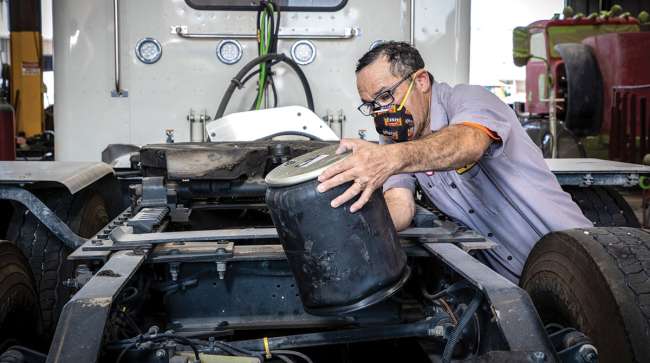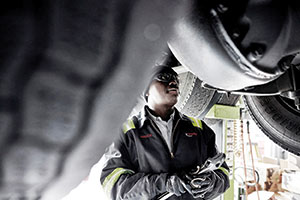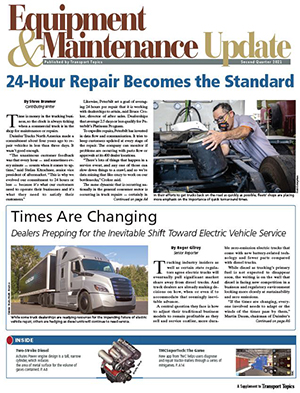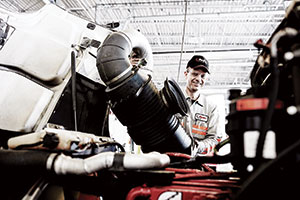Special to Transport Topics
24-Hour Repair Becomes the Standard

[Stay on top of transportation news: Get TTNews in your inbox.]
Time is money in the trucking business, so the clock is always ticking when a commercial truck is in the shop for maintenance or repairs.
Daimler Trucks North America made a commitment about four years ago to repair vehicles in less than three days. It wasn’t good enough.
“The unanimous customer feedback was that every hour — and sometimes every minute — counts when it comes to uptime,” said Stefan Kürschner, senior vice president of aftermarket. “This is why we evolved our commitment to 24 hours or less — because it’s what our customers need to operate their businesses and it’s what they need to satisfy their customers.”

Trucking companies are working to maintain a high-percentage uptime rate by applying a disciplined maintenance regimen and round-the-clock emergency service. (Ryder)
Likewise, Peterbilt set a goal of averaging 24 hours per repair that it is working with dealerships to attain, said Bruce Croker, director of after sales. Dealerships that average 2.5 days or less qualify for Peterbilt’s Platinum Program.
To expedite repairs, Peterbilt has invested in data flow and communication. It tries to keep customers updated at every stage of the repair. The company can monitor if problems are occurring with parts flow or approvals at its 400 dealer locations.
“There’s lots of things that happen in a service event, and any one of those can slow down things to a crawl, and so we’re data mining that like crazy to work on our bottlenecks,” Croker said.
The same dynamic that is occurring nationally in the general consumer sector is occurring in truck repairs — certainly in parts distribution, said Mike Eppes, managing vice president of operations for the Rush Enterprises truck dealerships.
“When Amazon and others are delivering next-day or even same-day, that becomes your expectation in your business world as well,” he said.
Rush has route-optimized its delivery vehicles to get parts to customers faster. Customers can go to portals and order parts 24/7, ensuring their place in the queue when warehouse employees arrive. The company is implementing a new call center system that leverages data analytics so it can be staffed based on customers’ actual needs.
Mobile repairs have helped improve Rush Enterprises’ service by reducing dwell time, said Victor Cummings, vice president of service. The company has 500 mobile technicians, many of them embedded with fleets.

More Q2 EMU stories
It’s not only dealerships and manufacturers that are feeling the pressure to repair trucks quickly. Jeff Harris, vice president of maintenance for Van Buren, Ark.-based USA Truck, said his company sets an estimated time out of the facility on all equipment.
“Operations is just waiting on you,” he said. “They just want to know when you’re going to have it done, and do they need to make a move with the driver?”
Harris said the push for faster repairs is being driven by hours-of-service requirements. The driver’s 10-hour clock can’t be reset. Fleets must put a dollar figure on a lost 24 hours.
The company tracks internal and external repair times. Internal times have been falling in recent years. USA Truck doesn’t have to wait on other fleets, and labor is cheaper. As a result, since Harris joined the company in 2017, it has added four repair facilities along its lanes.
USA Truck ranks No. 67 on the Transport Topics list of the Top 100 For-Hire Carriers in North America.
Salt Lake City-based C.R. England’s shops have a target of under 10 hours for any repair, said Doug Kading, vice president of maintenance. Within 15 minutes of assessing the vehicle, technicians enter an estimated completion time that is plus or minus one hour with an accuracy target of 75%. That time is written on the vehicle with a grease pencil so it can be seen.
Shops measure repairs down to the minute — when the unit broke the geofence and hit the yard, and when the work order was completed. C.R. England ranks No. 26 on the TT 100.
“We’re trying to push the dealers to kind of do the same thing: Geofence your lot,” Kading said. “Don’t tell me when you wrote the work order up. Tell me how long, again, it was physically present at your location.”
His fleet runs more than 95% Freightliners with the rest Navistars, but he said all the manufacturers produce good trucks. Because of that, service has become a differentiator.
Providing a Reliable Service
Shane Barnes, P.A.M. Transport vice president of maintenance, said his fleet has never set a 24-hour benchmark. It just tries to get trucks back on the road as quickly as possible. He said dealers’ express triage lanes have improved uptimes.
“In the old days, a carrier’s wait would depend on whatever kind of truck repairs were in front of it,” he said. “You might be behind an oil change, or you might be behind an engine swap.”
Tontitown, Ark.-based P.A.M. Transport ranks No. 68 on the TT Top 100 list.
Penske Truck Leasing has sped up the repair process through data-based guided repairs. Meanwhile, preventative maintenance is all voice directed and differentiated by year, make and model, said Chris Hough, vice president of maintenance services. Technicians wearing headsets are guided through each step, which can change that day based on data showing increased failure rates on a particular part for a particular vehicle.

Fleets are realizing that a 24-hour return on a down vehicle is a reasonable time frame as customers' expectations on service times become more demanding. (Ryder)
Penske technicians, meanwhile, say either “pass” or “fail” into the headset for each step. The “fails” automatically are added to a repair order. The process saves up to 30 minutes in paperwork time. Ryder’s Bill Dawson, vice president of maintenance and engineering, said some of his company’s 800 shops are open 24 hours, and employees are on call 24/7. The company tries to maintain a 95% uptime through a strong preventative maintenance program. Some customers expect repairs in 24 hours, but some with especially tight delivery windows need it done overnight.
“Depending on the nature of the repair, a 24-hour return on a down vehicle is pretty reasonable. I think customers have the right to expect that,” he said.
Ryder Supply Chain Solutions ranks No. 10 on the TT Top 100 list.
Paul Romanaggi, Daimler Trucks North America’s chief customer experience officer, said fleet customers see responsive, transparent service in their daily lives and expect it in their business dealings.
To accommodate that expectation, Daimler has opened four parts distribution centers in the United States over the last five years, enabling it to deliver 90% of dealer orders in under 12 hours. Ten dealer rooftops with more than 50 service bays will be added in 2021 after 700 bays were announced in 2020.
Daimler is also expanding its digital and technological capabilities. Among its efforts is its HoloLens augmented reality platform being piloted with Microsoft, said Admir Kreso, general manager, service.
Other truck manufacturers are responding to fleets’ need for speed. Volvo Trucks North America has more than 190 Certified Uptime Dealers that can ensure initial vehicle diagnostics are completed within two hours of arrival, said Magnus Gustafson, vice president, aftermarket quality and operations.
Ray Hastings, Mack director of national accounts for customer support, said Mack tries to get as many units as possible repaired the same day as the event. Thanks to data analytics, it has more ways to track repairs. He said fleets are getting better at using telematics data to determine average downtimes. They are becoming more sophisticated in holding manufacturers accountable in their total cost of ownership and are using that information to determine future purchases.
Meena Narahari, Navistar’s director, total cost of ownership and uptime, said fleets want manufacturers to use vehicle data to predict when repairs will be needed and plan those repairs to prevent disruptions. Its “Advanced Preventative Maintenance” tool recommends the best time for an oil change. Narahari said pilot customers say it has eliminated at least one oil change per year. The company is using telematics data to predictively allocate parts at its distribution centers, and it’s piloting a predictive parts allocation at the dealer level.
Want more news? Listen to today's daily briefing below or go here for more info:




